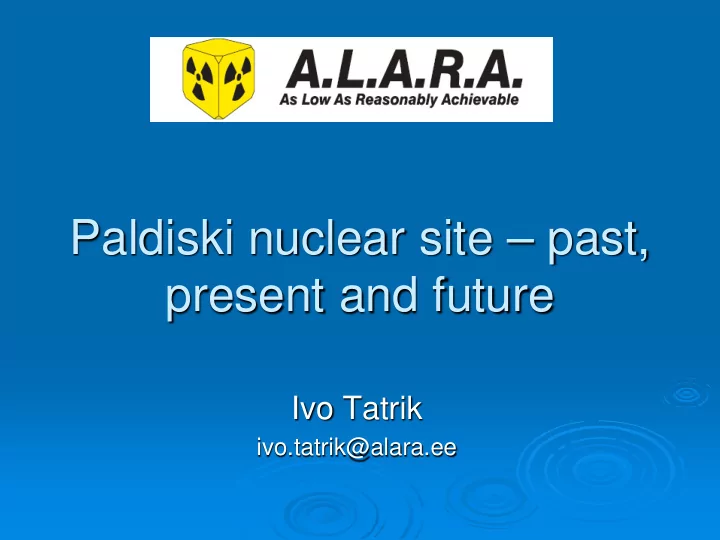

Paldiski nuclear site – past, present and future Ivo Tatrik ivo.tatrik@alara.ee
Status of A.L.A.R.A. • Estonian state owned radioactive waste management agency • Established 1995 for decommission and clean up of Former Nuclear Submarine Training centre in Paldiski • Operates Interim Storage in Paldiski and is involved with decommissioning of Tammiku near surface disposal facility • Emergency response for orphan sources
Radioactive waste storage facilities in Estonia Paldiski site Tammiku disposal site
Paldiski - history
Paldiski site – history Main Technological Building was erected 1960-1963 Unit 1 Unit 2 Thermal power 70 MW 90 MW Reactor type PWR Enrichment of fuel (in 235 U) 20 % First criticality 1968 1983 Shut down 1989 Refuelling 1980 never Operating time 20 821 h5 333 h Fuel removed and sent back to Russia 1995
Paldiski site – history (2) The reactors are defueled, all the systems components, pipelines and tanks has been drained; High-pressure gas and air has been removed from cylinders and systems of the reactor compartments; Reactor compartments are welded and there is no access.
Paldiski site – history (3) About 70 m 3 concrete was poured inside RC; Concrete sarcophagus around reactor compartments were erected; Air drying and monitoring system were installed.
Paldiski site – history (4) o Decision about deferred decommissioning for 50 years was made 2001 in order to wait until main dose contributors decay; o Extensive works were held between 1995-2008 to prepare site for safe storage until 2039 including: - decommissioning of solid and liquid waste storages; - removal of auxiliary systems of reactors; - removal of underground contaminated piping's (3 km); - decontamination and demolition of auxiliary buildings. o Radioactive waste raised from decommissioning process were packed and stored in interim storage.
Paldiski site – history (5)
Paldsiki site - today
Paldiski site – today (2) • Reactors are stored safely; • Both reactors and environment monitoring programs are active; • Reactors program: on-line alpha and beta aerosols, gamma dose rate; • Environmental program: water, grass and ground – 3 H, 137 Cs, 60 Co, 90 Sr
Paldiski site – today (3)
Paldiski site – future • Reactors will be dismantled after 50 years decay of main dose contributors (Co-60); • Decommissioning will start 2039; • Before decommissioning final disposal for radioactive waste will be built; • Preliminary studies for decommissioning of reactors and establishing of repository for radioactive waste were conducted 2014-2015.
Paldiski site – future (2) Decommissioning outcomes: • Reactor compartments will be cut in small pieces to fit in standard containers; • Reactors vessels will be disposed as whole, without cutting, in special containers; • There will be 3 types of waste: a) low level radioactive waste (LLW); b) Intermediate level waste (ILW); c) free released waste.
Paldiski site - future (3) Final disposal outcomes: Disposal volumes: LLW – 2100 m 3 ; • ILW – 900 m 3 . • 89% of waste is legacy waste • There will be need for 2 type of disposal facilities: A) near surface facility; B) shaft type facility.
Surface repository concept (1) Ferro-concrete vault with wall thickness 40 cm; • Dimensions: length 14 m, width 12,5 m and height 6 m; • 2 sections side by side; • After filling each layer, all voids between packages will be • backfilled with concrete; Similar repositories existing in France, Spain etc. •
Surface repository concept (2) Disposal packages (existing): o concrete containers (fits also for intermediate depth repository); o ISO containers; o 200 l drums; o control rod containers.
Intermediate depth repository concept (1) Shaft outer diameter 10,4 m. • Depth 50 m, waste emplacement • depth 30-50 m (1400 m 3 ). Shaft is lined with pre-fabricated • ferro-concrete elements. Wall thickness 50 cm. • Waste types: LL-LLW and ILW • 226 Ra (sealed sources, contaminated materials, reactor vessels as whole, biological shield tanks). Backfilled with concrete. • Similar pilot repositories existing or • planned to build in Finland, Sweden, South Korea, Slovenia and Russia.
Preliminary site selection (1) This was only first step in site selection process and aim was to • map possible suitable areas. Site has to accommodate both type of repositories. Based on existing geological, hydrogeological and social data • and international experience 3 sites/areas were selected. From experts point of view current Paldiski site or it’s vicinity is • the most suitable area for final disposal. Geological and hydro geological conditions of Paldiskis are equal to other sites but waste transportation, infrastructure and social aspects are by far the best ones.
Preliminary site selection (2)
Costs and political decisions Whole program cost (decommissioning + final disposal) about 90 • million euro. Site selection, design and construction, management of existing • waste and licensing process cost about 45 million euro (~50%). “0 option” cost may rise up to 50 million euro in the future. • Specific studies as part of Environmental Impact Assessment for the • establishment of a radioactive waste repository will start at 2018. Decision by Government was made April 28, 2016 that Ministry of • Economic Affairs and Communications will be the responsible authority who arrange radioactive waste storage and disposal activities in Estonia. It was fixed in new Radiation Act adopted by the Parliament on 8 of June 2016.
Thank You for attention!
Recommend
More recommend